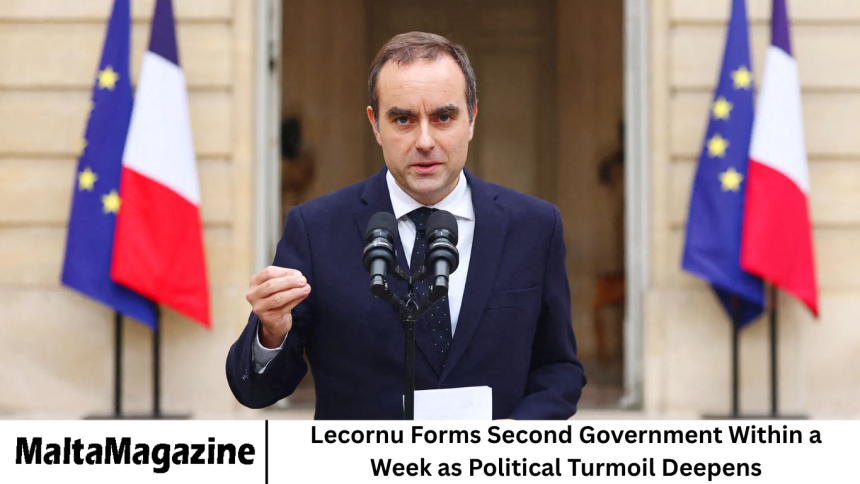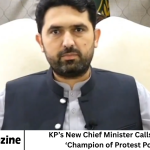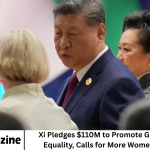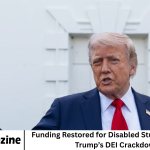France finds itself at yet another political crossroads as Sébastien Lecornu, newly appointed Prime Minister, has formed his second government within a single week amid an escalating political crisis that has left the nation’s leadership in flux.
- A Week of Upheaval: How France Got Here
- The Composition of Lecornu’s Second Government
- Macron’s Political Gamble
- Challenges Ahead for Lecornu
- Economic Recovery and Inflation:
- Social Unrest and Protests:
- Environmental Policy:
- Foreign Policy Tensions:
- Restoring Public Trust:
- Public Reaction and Street Protests
- Reactions from Political Rivals
- France’s Institutional Crisis Deepens
- International Response
- Media Coverage and Public Discourse
- Historical Context: When France Faced Similar Turmoil
- Possible Scenarios Ahead
- Frequently Asked Question
- Conclusion
The swift reshuffle underscores the deep divisions within President Emmanuel Macron’s centrist coalition and the growing pressure from both right-wing and left-wing blocs in Parliament. In an extraordinary series of developments that have unfolded over just a few days.
Lecornu’s attempt to stabilize the administration has exposed the fragility of the government’s support base. With mounting calls for a snap election, street protests erupting across major French cities, and internal disputes rocking Macron’s alliance, France’s Fifth Republic is once again testing the limits of its political resilience.
More Read: Macron Blames Rivals as France’s Political Turmoil Deepens
A Week of Upheaval: How France Got Here
France’s latest political drama began when former Prime Minister Gabriel Attal tendered his resignation following months of gridlock and mounting criticism from both Parliament and the public. Attal’s government had faced difficulties passing critical budgetary and social reforms.
The failure to unite the National Assembly around key legislation pushed Macron to act decisively. In a surprise move, Macron appointed Sébastien Lecornu—then serving as Minister of the Armed Forces—as the new Prime Minister.
Lecornu, a loyal Macron ally known for his pragmatic approach, was seen as someone who could potentially rebuild bridges within the divided political landscape. However, only a few days into his tenure, Lecornu’s first cabinet ran into immediate trouble.
Key appointments were criticized as “continuations of the same elite circle,” sparking backlash not only from the opposition but also from within Macron’s own Renaissance party. Several ministers refused to serve, citing policy disagreements and concerns over the direction of the government.
By the end of the week, Lecornu was compelled to dissolve his initial cabinet and announce a second, revised government—a rare and telling development in modern French politics.
The Composition of Lecornu’s Second Government
Lecornu’s second cabinet seeks to project an image of renewal and inclusion, balancing continuity with an effort to bring in fresh perspectives. The reshuffle includes a mix of veteran figures and new political faces, signaling Macron’s attempt to recalibrate his administration without completely abandoning his core team.
Among the key appointments:
- Bruno Le Maire retained his position as Minister of Finance, signaling continuity in France’s economic strategy.
- Aurélien Rousseau returned as Minister of Health, after previously resigning amid disputes over healthcare funding.
- Yaël Braun-Pivet, former President of the National Assembly, was appointed Minister of the Interior—a move that surprised many political observers.
- Clément Beaune, a prominent pro-European figure, was reassigned to head the Ministry for European and Foreign Affairs.
- New additions included Sabrina Agresti-Roubache, who was given a newly created portfolio for Social Cohesion and Citizenship.
While the cabinet features some symbolic changes, critics argue that Lecornu’s reshuffle still falls short of addressing the deeper structural and ideological fractures within the government.
Macron’s Political Gamble
President Emmanuel Macron’s decision to replace Attal with Lecornu—and to approve two government formations within a week—has been viewed as a high-stakes gamble. Macron’s approval ratings have been steadily declining, and the loss of his absolute majority in the National Assembly has constrained his ability to govern effectively.
Macron’s political opponents have seized on the chaos to depict him as out of touch with the electorate. Marine Le Pen’s National Rally and Jean-Luc Mélenchon’s France Unbowed have both framed the reshuffle as evidence of Macron’s weakening grip on power.
Meanwhile, moderate centrist allies have expressed frustration at what they see as “constant improvisation” in the government’s direction. The president’s decision to back Lecornu—considered a safe, loyal choice.
Reflects Macron’s preference for continuity in a time of turbulence rather than risking an outsider who might destabilize the balance of power even further. Political analysts suggest that Macron is attempting to buy time—using Lecornu’s appointment as a buffer—to avoid a full-scale parliamentary showdown or a potential dissolution of the National Assembly.
Challenges Ahead for Lecornu
Despite the new team, Prime Minister Lecornu faces an uphill battle. His government will need to navigate a National Assembly that remains deeply polarized. Without a parliamentary majority, Lecornu will likely rely on Article 49.3 of the French Constitution.
Allowing the government to pass legislation without a vote, unless a motion of no confidence is adopted. However, frequent use of this constitutional mechanism has historically angered both lawmakers and the public.
Key challenges include:
Economic Recovery and Inflation:
With France’s inflation rate remaining stubbornly high, Lecornu’s cabinet must find ways to stabilize purchasing power, tackle energy costs, and stimulate growth without deepening fiscal deficits.
Social Unrest and Protests:
The government’s reform agenda—especially on pensions and immigration—has reignited protests across the country. Unions have announced renewed strikes, warning of “mass mobilizations” against austerity.
Environmental Policy:
The administration is under pressure to meet France’s ambitious climate goals. Environmental groups have criticized Macron’s government for “greenwashing” and failing to deliver concrete emissions reductions.
Foreign Policy Tensions:
France’s role in the European Union, its strained relations with African nations after recent coups, and its position on global conflicts will test Lecornu’s diplomatic capabilities.
Restoring Public Trust:
Perhaps the greatest challenge of all is restoring faith in the political system itself. Polls show a sharp decline in public confidence in government institutions, with many citizens viewing the constant reshuffling as proof of dysfunction.
Public Reaction and Street Protests
The announcement of Lecornu’s second government has sparked a wave of reactions across France. In Paris, Lyon, and Marseille, demonstrators gathered to denounce what they called a “carousel of political elites” detached from everyday struggles.
Labor unions and student groups have organized coordinated protests, demanding higher wages, affordable housing, and climate action. The CGT, one of France’s largest labor unions, accused the government of “recycling the same ministers responsible for failed policies.”
Public opinion polls reveal a divided sentiment. According to an Ifop survey, 62% of respondents believe the reshuffle will not bring significant change, while only 23% expressed confidence in Lecornu’s leadership.
In media interviews, ordinary citizens voiced frustration with the “political merry-go-round.” Many said they had little faith that the new cabinet would address France’s pressing economic and social challenges.
Reactions from Political Rivals
Opposition leaders have wasted no time in criticizing the government reshuffle. Marine Le Pen described Lecornu’s appointment as “a desperate attempt to maintain control,” while Jean-Luc Mélenchon called it “a technocratic shuffle that changes nothing.”
On the center-right, Republican Party leader Éric Ciotti argued that Macron’s coalition has “run out of ideas and legitimacy,” and renewed his call for snap parliamentary elections.
Even within Macron’s own camp, whispers of dissatisfaction have surfaced. Some lawmakers from the Renaissance and Horizons parties have privately questioned whether Lecornu’s leadership can truly unify the fragmented majority.
However, Lecornu’s allies insist that the Prime Minister represents a “bridge between institutions and citizens.” They argue that his calm demeanor and administrative experience make him the right person to guide France through turbulent times.
France’s Institutional Crisis Deepens
The rapid succession of governments reflects a deeper institutional challenge facing the French Fifth Republic. Designed to provide strong presidential authority, the system has come under strain as Macron’s centrist bloc lost its parliamentary dominance in the 2022 elections.
The current impasse—marked by legislative paralysis, public disillusionment, and ideological fragmentation—has prompted renewed debates about constitutional reform.
Some political scholars argue that France may need to rethink its executive-legislative balance, while others suggest that frequent reshuffles are simply a symptom of political realignment in a changing society.
Lecornu’s government, therefore, is not just another cabinet—it is a test of the Fifth Republic’s endurance in the face of mounting populist and institutional pressures.
International Response
European leaders have reacted cautiously to the developments in Paris. German Chancellor Olaf Scholz expressed “confidence in France’s democratic stability,” while also emphasizing the importance of continued Franco-German cooperation.
The European Commission, meanwhile, reiterated that it expects France to maintain fiscal discipline despite political turbulence. Markets responded with mild volatility, with the euro dipping slightly against the dollar following the announcement of Lecornu’s second government.
In Washington, the State Department issued a brief statement expressing that “France remains a vital ally and partner of the United States,” underscoring the resilience of transatlantic relations.
However, foreign diplomats privately acknowledge that France’s domestic instability could limit its ability to lead on key EU initiatives, such as defense integration and energy reform.
Media Coverage and Public Discourse
French media outlets have offered extensive coverage of Lecornu’s second government, with headlines oscillating between cautious optimism and deep skepticism.
Le Monde described the reshuffle as “an act of political survival,” while Le Figaro highlighted Lecornu’s “difficult mission to restore authority.” Left-leaning Libération, meanwhile, accused the government of “playing musical chairs while the country burns.”
Television debates have dominated primetime slots, featuring heated exchanges between analysts, opposition figures, and government spokespeople. Social media platforms have amplified the conversation, with hashtags such as #Lecornu2 and #CrisePolitique trending for days.
Public sentiment online reflects widespread fatigue with political instability. Memes comparing France’s rapid cabinet changes to “football team substitutions” have gone viral, illustrating how humor has become a coping mechanism for citizens disillusioned by politics.
Historical Context: When France Faced Similar Turmoil
Political reshuffles are not new to France. The Fifth Republic, established in 1958 under Charles de Gaulle, has weathered numerous crises—from student uprisings in 1968 to economic recessions and contentious pension reforms.
However, forming two governments in a single week is exceptionally rare. The last comparable episode occurred in the early 1990s, when Prime Minister Édith Cresson was replaced amid collapsing approval ratings. Yet even then, the transition was not as rapid or turbulent as the current situation.
Historians note that France has always balanced between stability and revolution—a nation that tolerates authority only until it no longer delivers results. Lecornu’s predicament, they argue, is part of a broader pattern of periodic political reawakening in French history.
Possible Scenarios Ahead
Several possible paths lie ahead for France:
Short-Term Stability:
Lecornu could manage to stabilize the situation by negotiating ad hoc coalitions and adopting a pragmatic, issue-by-issue approach in Parliament.
No-Confidence Motion:
Opposition parties may attempt to topple the new government through a vote of no confidence. While success is uncertain, it would further weaken Macron’s credibility.
Snap Elections:
Macron could dissolve the National Assembly and call for early legislative elections—a risky move that could strengthen the far-right if voters seek to punish the ruling bloc.
Gradual Realignment:
The crisis might lead to a slow reconfiguration of French politics, with centrist factions merging and extremist forces either gaining or losing momentum based on how Lecornu performs.
Each of these outcomes carries significant implications not only for France but also for Europe’s broader political landscape.
Frequently Asked Question
Why did Sébastien Lecornu form a second government within a week?
Lecornu formed a second government because his initial cabinet faced strong internal dissent and public criticism. Several ministers declined to serve, and opposition from within Macron’s coalition forced him to reshuffle and rebuild a more balanced, politically inclusive team.
What prompted Macron to replace former Prime Minister Gabriel Attal?
Gabriel Attal resigned after months of political paralysis, failed reforms, and growing discontent within the National Assembly. Macron chose Lecornu to restore stability and reassert executive control amid mounting public frustration.
How has the French public reacted to Lecornu’s new government?
Public response has been largely skeptical. Polls indicate that most citizens doubt the reshuffle will lead to real change. Protests have erupted across major cities, reflecting broader frustration with political stagnation and economic hardship.
What are the main challenges facing the Lecornu government?
Lecornu faces multiple challenges: economic inflation, social unrest, environmental demands, foreign policy tensions, and declining public trust in institutions. Managing these simultaneously will test the resilience of his leadership.
Could this crisis lead to new elections in France?
Yes. If Lecornu fails to secure parliamentary support or if opposition parties pass a vote of no confidence, Macron may be forced to call snap legislative elections to resolve the impasse.
How does this situation affect France’s position in the European Union?
While France remains a key EU member, domestic instability could limit its influence in shaping EU policy, particularly on defense, energy, and migration. European partners are watching closely for signs of stability.
What does this turmoil mean for Macron’s political future?
The crisis threatens Macron’s legacy as a reformist leader. If Lecornu’s government fails to deliver, Macron could face pressure to dissolve Parliament or risk further erosion of his authority in his final presidential years.
Conclusion
Sébastien Lecornu’s rapid formation of a second government within a week encapsulates the deep volatility of French politics in 2025. The reshuffle highlights both the fragility of Macron’s centrist project and the resilience of France’s democratic institutions under pressure.
Whether Lecornu can steer the government through this storm remains uncertain. His ability to build consensus, manage economic turbulence, and reconnect with citizens will determine not only his own legacy but also the trajectory of France’s Fifth Republic in the years to come.









